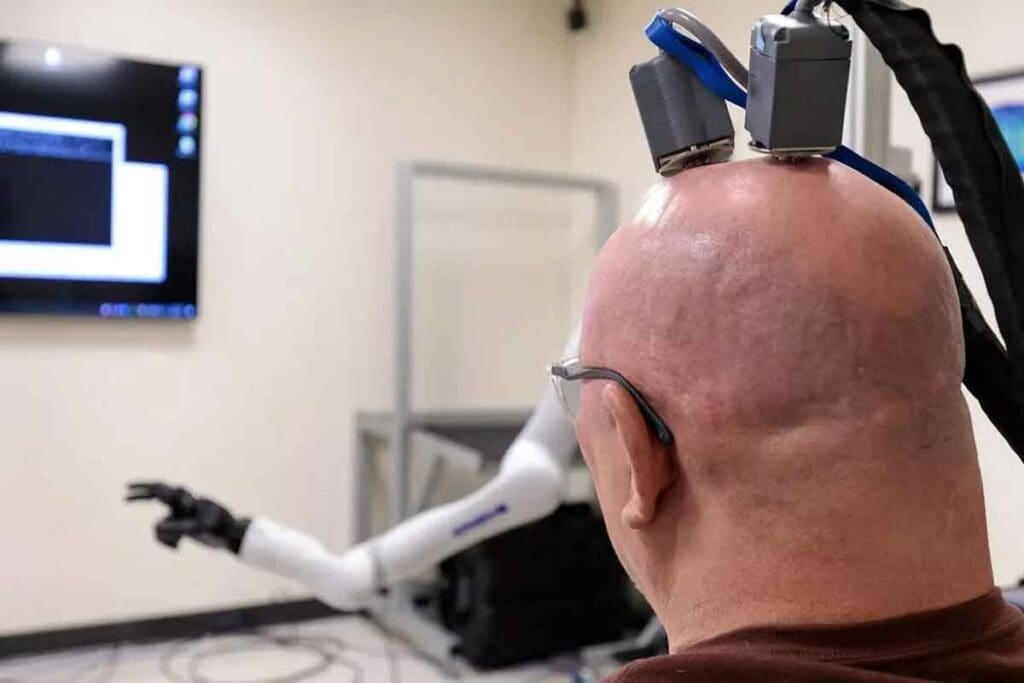Last Updated on November 26, 2025 by Bilal Hasdemir

Dealing with brain health issues can be tough. Brain embolization is a cutting-edge treatment that has changed how we tackle brain problems.
This method is a small, non-invasive way to stop bad blood flow in the brain. It’s done through tiny tubes called catheters. It helps with things like abnormal blood vessels, aneurysms, and some tumors.
New developments in embolization procedures have made them better. Now, thanks to better pictures and materials, patients get even better care. Places like Liv Hospital focus on making sure patients are at the center of their care.
Key Takeaways
- Understanding brain embolization is key for those with brain health issues.
- Cerebral embolisation is a small, non-invasive way to treat brain problems.
- New tech has made imaging and materials used in embolization better.
- Top hospitals offer safe, advanced treatments.
- Putting the patient first is important in brain embolization.
What Is Cerebral Embolisation?

Cerebral embolisation is a precise procedure that delivers embolic materials to specific brain areas. It’s a new way to treat brain conditions without the need for open surgery. This method is less invasive and more effective.
Exploring cerebral embolisation, we see how it works. Doctors use a catheter to reach the brain from the leg. They use live images to guide them, making the treatment very accurate.
Definition and Basic Principles
Cerebral embolisation, or brain embolization, blocks blood vessels in the brain. It uses materials like platelet aggregates, thrombus, or other foreign materials to stop blood flow. This helps prevent bleeding or ischemia.
The goal is to block the bad blood vessels. Doctors use catheters and special agents under live images. This makes the treatment precise and safe.
Evolution of Brain Embolization Techniques
The techniques for brain embolization have greatly improved. New materials and better catheters and imaging have made it safer and more effective.
Today, doctors use flow-diverting stents and liquid embolic agents. These tools help treat more conditions and improve patient results. Cerebral embolisation is now a key part of treating complex brain diseases.
Key Fact #1: How Cerebral Embolisation Works
Cerebral embolisation blocks specific blood vessels to treat brain issues. It’s key to managing many brain vascular problems.
The Science Behind Blood Flow Blockage
A catheter is guided from the femoral artery to the brain. Real-time imaging helps place it accurately. Embolic materials are then used to stop abnormal blood flow.

“The goal of cerebral embolisation is to safely and effectively block abnormal blood flow, alleviating risks from neurovascular abnormalities.”
Expert in Neurovascular Treatment
Types of Embolic Materials Used
Many embolic materials are used in cerebral embolisation. Each has its own use and benefits. The right material depends on the condition and the patient’s health.
| Embolic Material | Characteristics | Common Applications |
| Coils | Platinum or other biocompatible materials, varying sizes | Aneurysm treatment, vessel occlusion |
| Liquid Embolic Agents | Rapidly polymerizing liquids, such as Onyx | AVM treatment, tumor embolisation |
| Particles | Various sizes, made from materials like PVA or microspheres | Tumor embolisation, vascular malformations |
Knowing about different embolic materials is important. It shows how cerebral embolisation is versatile and effective.
Key Fact #2: Major Conditions Treated with Brain Embolization
Neurovascular conditions like arteriovenous malformations and aneurysms are treated with brain embolization. This method is key to preventing many brain diseases. It helps manage various vascular issues in the brain.
Arteriovenous Malformations (AVMs)
Arteriovenous malformations (AVMs) are abnormal brain connections. They can cause serious problems, like bleeding and brain damage.
“AVMs are a significant cause of intracranial hemorrhage in young adults,”
This shows why treating AVMs is so important. We use embolization to stop abnormal blood flow. This reduces the risk of serious complications.
Brain Aneurysms
Brain aneurysms are also treated with brain embolization. An aneurysm is a bulge in a blood vessel that can burst. This can lead to bleeding in the brain.
“The goal of aneurysm embolization is to exclude the aneurysm from the circulation, preventing rupture and improving patient outcomes.”
Vascular Tumors and Other Conditions
Vascular tumors, like meningiomas, can be treated with brain embolization. This method reduces blood flow to tumors, making surgery safer. It also helps with other conditions, like dural arteriovenous fistulas (DAVFs).
Embolization makes surgery easier and more effective. It’s a powerful tool in treating brain diseases.
Key Fact #3: The Cerebral Embolization Procedure Explained
The cerebral embolization procedure is a complex intervention. It needs precise planning and execution. Understanding the stages from preparation to embolization is key.
Pre-procedure Preparation and Assessment
Before the procedure, patients get a thorough assessment. This includes reviewing their medical history and conducting imaging tests. They also discuss risks and benefits. Pre-procedure preparation is critical for the best outcomes.
Transesophageal echocardiography can find hidden causes of strokes. The most common cause is a patent foramen ovale. Finding these conditions helps tailor the procedure to the patient.
Catheter Navigation from the Femoral Artery to the Brain
The procedure involves guiding a catheter from the femoral artery to the brain. This requires exceptional skill and precision. The catheter must navigate through the vascular system without causing damage.
We use advanced catheter technologies for safe navigation. The catheter is guided through the arterial system to the cerebral vasculature. This is done with minimal risk of complications.
Real-time Imaging Guidance Techniques
Real-time imaging is essential for the procedure. Techniques like fluoroscopy and digital subtraction angiography provide real-time visualization. They help place embolic materials precisely.
Real-time imaging makes the procedure safer and more effective. It allows for quick adjustments during the procedure. This ensures the best possible outcomes.
Key Fact #4: Aneurysm Embolization Techniques
We use advanced techniques to treat intracranial aneurysms. Aneurysm embolization is key for both ruptured and unruptured aneurysms. It’s a less invasive option compared to traditional surgery.
These techniques have greatly improved, giving hope to those with life-threatening vascular issues. The main methods include coil embolization and flow diversion strategies.
Coil Embolization for Aneurysms
Coil embolization is a common method for treating aneurysms. A catheter is guided to the aneurysm, where coils are placed. This helps clot the aneurysm and stops blood flow.
The WEB device is also used for treating aneurysms. It’s a mesh device for wide-necked aneurysms. It’s a new option for complex aneurysms.
Flow Diversion Strategies
Flow diversion is a newer treatment. It involves placing a stent across the aneurysm’s neck. This changes blood flow, helping the aneurysm to clot and eventually close off.
Flow diversion is great for complex or giant aneurysms. The stent not only treats the aneurysm but also helps keep blood flowing to the brain.
In summary, aneurysm embolization techniques, like coil and flow diversion, are big steps forward. They offer effective, less invasive treatments for intracranial aneurysms, reducing risks from traditional surgery.
Key Fact #5: Pre-surgical Embolization Benefits
Pre-surgical embolization offers many benefits, making surgery safer and more effective. It helps a lot, mainly for people with complex vascular issues or high-risk tumors.
Reducing Blood Supply to High-Risk Tumors
Pre-surgical embolization is very helpful for tumors or malformations at high risk. It cuts down the blood flow to these areas. This makes surgery safer by reducing the chance of too much bleeding.
Key benefits of reducing blood supply include:
- Less blood loss during surgery
- Better view of the area being operated on
- Less need for blood transfusions
- More safety in the surgery
Coordination with Surgical Resection Planning
Pre-surgical embolization is done with careful planning for surgery. Our team works with neurosurgeons and radiologists to plan the embolization. This makes sure it fits the patient’s and the surgical team’s needs.
For example, in brain tumors or AVMs, embolization can selectively target blood vessels. This makes it easier for surgeons to remove the tumor during surgery.
The coordination process involves:
- Detailed imaging and assessment of the lesion
- Planning the embolization procedure to optimize surgical conditions
- Collaboration between interventional radiologists and neurosurgeons
- Timing the embolization and surgery to maximize patient benefit
By adding pre-surgical embolization to the treatment plan, we can make surgery more effective. This improves patient outcomes.
Key Fact #6: Risks and Complications of Brain Embolization
Brain embolization is generally safe but comes with risks and complications. It’s important to know the possible side effects and complications that can happen.
Common Side Effects and Their Management
Side effects like headache, nausea, and discomfort at the catheter site are common. These are usually managed with medication and rest. Managing these side effects well is key to a smooth recovery.
Serious Complications to Be Aware Of
Though rare, serious complications can occur. These include stroke, infection, or damage to blood vessels. Knowing these risks helps in making informed decisions.
| Complication | Description | Frequency |
| Stroke | Blockage or rupture of blood vessels in the brain | Rare |
| Infection | Infection at the catheter site or in the brain | Uncommon |
| Vessel Damage | Damage to the blood vessels during the procedure | Rare |
Patient-Specific Risk Factors
Risk factors like the size and location of the aneurysm or malformation vary. We evaluate these factors for each patient to offer personalized care.
Key Fact #7: Recovery and Long-term Outcomes
Patients need to know about recovery and long-term results after cerebral embolization. The procedure uses real-time imaging for accuracy. This greatly affects how well a patient recovers.
Immediate Post-Procedure Care
Right after the procedure, patients are watched closely in a recovery unit. We stress the need for close monitoring. This is to quickly handle any problems, like blood clots or blockages caused by the procedure.
Patients usually have to stay flat and quiet for a few hours. This helps prevent bleeding at the catheter site. Our team gives clear instructions on care, including medication and follow-up visits.
Long-term Follow-up Protocol
Regular check-ups are key to seeing how well the embolization worked. We also watch for any long-term issues. This includes regular visits and imaging tests to check on healing.
Here’s a typical follow-up plan for patients after cerebral embolization:
| Follow-up Timeframe | Assessment | Imaging Studies |
| 1-3 months | Clinical assessment | MRA or CTA |
| 6-12 months | Clinical assessment, symptom review | DSA or MRA |
| 1-2 years | Long-term outcome assessment | MRA or CTA as needed |
Following this plan helps us ensure the best long-term results for our patients.
Advances in Modern Cerebral Embolisation Technology
Modern cerebral embolisation is changing how we treat brain conditions. New technologies are making treatments safer and more effective. This is a big step forward in endovascular therapy.
Next-Generation Embolic Materials
New embolic materials are key in modern cerebral embolisation. They are made to work better and be safer, lowering the chance of problems. For example, cerebral embolic protection devices (CEPD) help prevent strokes during certain procedures.
CEPD has been proven safe in many cases. It catches embolic debris and lessens brain burden.
Enhanced Imaging and Navigation Systems
There have also been big improvements in imaging and navigation systems. These systems offer real-time imaging guidance. This makes procedures more precise and safer for patients.
Future Directions in Endovascular Therapy
The future of cerebral embolisation looks bright. We expect even more advanced materials and better imaging systems. These advancements will help treat more conditions with endovascular therapy.
As we explore new possibilities in cerebral embolisation, our focus is on top-notch care for our patients. By using the latest technology, we aim to offer safer and more effective treatments. This will greatly improve the lives of those with neurovascular diseases.
Conclusion: The Future of Brain Embolization in Neurovascular Treatment
Looking ahead, brain embolization will keep being key in treating neurovascular issues like aneurysms and embolisms. It’s important to know the difference between an embolism, which blocks a blood vessel, and an aneurysm, which is a bulge in the vessel wall. Recent studies have shown that combining WEB with coils is effective and safe for treating certain aneurysms.
We expect technology and techniques to keep improving, leading to better results for patients. Brain embolization’s future looks bright, with possibilities for treating more complex cases. As treatments evolve, brain embolization will remain a vital part, bringing new hope to those with vascular conditions.
FAQ
What is cerebral embolisation?
Cerebral embolisation is a medical procedure. It treats neurovascular conditions by stopping abnormal blood flow to the brain.
What conditions are treated with brain embolization?
It treats conditions like arteriovenous malformations (AVMs), brain aneurysms, and vascular tumors.
How does cerebral embolisation work?
It uses materials to block abnormal blood vessels. This stops blood flow to specific brain areas.
What are the risks and complications associated with brain embolization?
It’s generally safe but can have risks. These include side effects, serious complications, and risks based on the patient. Always talk to a healthcare provider.
What is the difference between an aneurysm and an embolism?
An aneurysm is a blood vessel bulge. An embolism is when a clot blocks blood flow. Embolization treats both.
What is coil embolization for aneurysms?
Coil embolization fills an aneurysm with coils. This stops blood flow into the aneurysm.
What is the recovery process like after brain embolization?
Recovery includes immediate care and long-term follow-ups. These steps help ensure a smooth recovery and prevent complications.
What advancements are being made in cerebral embolisation technology?
New advancements include better embolic materials and imaging systems. These improvements aim to enhance endovascular therapy.
How does pre-surgical embolization benefit patients?
It reduces the blood supply to tumors or malformations. This makes surgery safer and more effective.
What is flow diversion in aneurysm treatment?
Flow diversion uses a device to redirect blood flow. This promotes clotting and reduces rupture risk.
Are there any long-term outcomes or follow-up required after brain embolization?
Yes, long-term follow-ups are key. They help monitor the procedure’s success and address any complications or recurrences.
References
- Fatania, K., & Patankar, T. (2021). Comprehensive review of the recent advances in devices for endovascular treatment of complex brain aneurysms. Radiology, Leeds Teaching Hospitals NHS Trust. https://pmc.ncbi.nlm.nih.gov/articles/PMC8722252/






